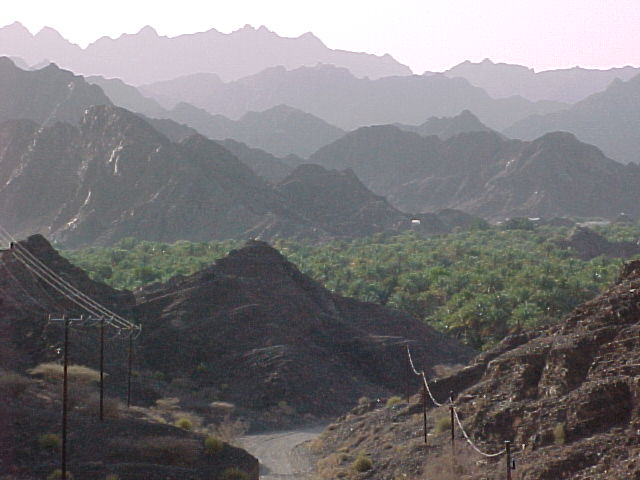Highlights of Wadi Khutwah (April 2004)

Contents
- The Donkey Trail
- Mountain Houses, Graveyard, Terrraces
- Around Sultan's Oasis
- Solar Clock and Miscellaneous
Highlights of Wadi Khutwah (April 2004)
Wadi Khutwah remains one of the most popular destinations for ENHG field trips owing to combination of archaeology and geology together with a host of flora and fauna.
The gardens at Khutwah have been undergoing a wholesale change in recent month with many of the date palms being removed, new terraces constructed and "cash crops" planted. Some of the new crops include mint, parsley, raddish, lettuce and dill. Consumers have started to drive to the "farm gate" to purchase produce though most of the crops are sold at area markets.
One of the possible explanations is the relatively low cash value of the date harvest in Oman where the government cannot offer the subsidies to farmers that are available in the United Arab Emirates. The cash crops can be harvested much more frequently, are always in demand, and, though they take slightly more maintenance than date palms, offer a steady income for the landholders and sharecroppers. In fact, there may be some changes in the economy of oasis gardens as it appears at least one of the newly developed farms is managed by laborers who rent the land for a fixed fee.
Elsewhere in the Khutwah area, we continue to find graves and evidence of the copper smelting that once provided a modest income for the residents, probably as a winter activity.
Upstream on the eastern side of the gorge, Sultan's oasis is suffering the drop in water levels though the date palms appear able to survive this season. Nearby (north of Sultan's oasis), evidence of a copper smelter was observed along with what appear to be pre-Islamic graves. These graves (photographs below) are unlike others found in the area with small, fine pieces of stone piled in a mound over the large stones that outline the grave. In the same vicinity is a silt trap built into the slope of the mountain.
The ongoing frustration is the lack of a source of the copper ore to feed the smelters found in the area. There are no obvious trails leading from the area of the smelters though the estimate is that the source of the copper ore is to the east and northeast of the old settlement.
One other development of Khutwah is the relocation, again, of the clock used to regulate the distribution of water. The original clock was damaged by weekend visitors who evidently did not realize they were parking their vehicles on the timepiece. In 2002, the residents installed a piece of drilling pipe in concrete in the town square, adding a concrete barrier behind the pipe in hopes tourists would not push the pipe over.
In April 2004, the new solar clock was relocated a few mete